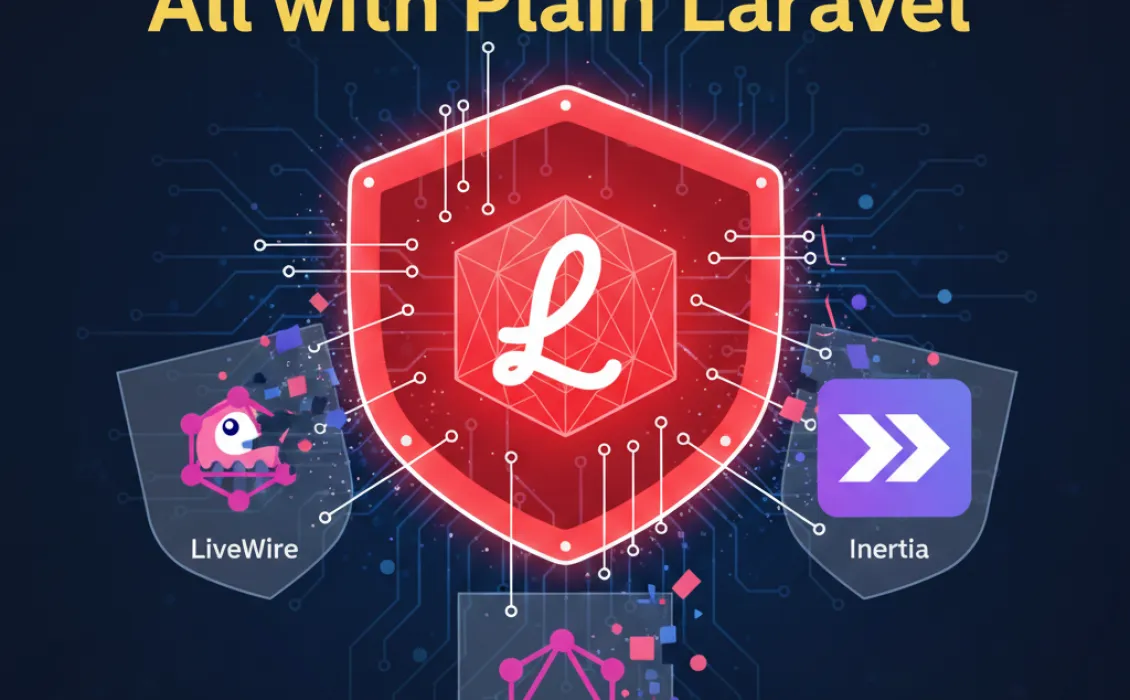Every few years, the Laravel ecosystem forgets how powerful it actually is. We start believing we need something else on top of it — something that promises “reactivity,” an “SPA feel,” or “exact data fetching.”
So we bolt on Livewire for “no-JS reactivity.” Inertia to feel “modern.” And GraphQL to “fetch only what you need.”
And suddenly, a simple Laravel app has more layers then needed as well as additional learning curves, all trying to fix problems that Laravel already solved.
This article is about walking back from that mess. It's about achieving the goals of these popular tools without ever leaving the comfort and simplicity of plain Laravel.
The Foundation: Laravel Was Always the Component Framework
Laravel’s request-response cycle was never a limitation; it’s the cleanest form of state management in web history. The problem isn’t that Laravel can’t be reactive—it’s that developers stopped using Blade the way it was meant to be used.
Blade was never the problem. It just got treated like a trash bin of mixed markup and business logic. But once you start giving your Blade files contracts and structure, as I explained in Stop Treating Your Blade Files Like Trash Bins, the entire architecture changes.
- Each Blade partial becomes a real, reusable component.
- Each partial expects a defined data shape, enforced by DTOs or queries.
- Each partial becomes testable and predictable.
This is the foundation. Now let’s see how it can replace Livewire, Inertia, and GraphQL—one by one.
The Real Problem: We Outsourced What Laravel Does Best
The promise of Livewire, Inertia, and GraphQL stems from three core desires:
- Dynamic UI updates without a full page reload.
- Seamless data exchange between the backend and frontend.
- Reusable, component-based UI parts.
Laravel can already do all of this. We’ve just stopped trusting its native capabilities because of a psychological dependency on JavaScript frameworks. So instead of using Laravel properly, we’ve started wrapping it in unnecessary layers.
Let's strip it down and rebuild from the foundation.
1. Dynamic UI: Livewire without Livewire
Livewire’s idea is clever: run backend logic on the server and send back rendered HTML over AJAX. But you don’t need the entire Livewire runtime to do that. Laravel can already render partial HTML views dynamically.
Here’s how. You can define a global partial route that acts as a universal entry point:
Route::post('{path}', function ($path) {
// Convert URL path to view dot notation
$view = str_replace('/', '.', $path);
// Sanitize to prevent directory traversal, etc.
$view = preg_replace('/[^A-Za-z0-9_.-]/', '', $view);
// Logic to resolve models, DTOs, and data based on the path
// For example, pull the first segment to resolve a model
$segments = explode('/', $path);
$modelKey = $segments[0] ?? null;
$modelInstance = $modelKey ? resolve_model_logic($modelKey) : null; // Your logic here
// Check if the Blade partial exists and render it
if (view()->exists($view)) {
// Pass relevant data to the view
return view($view, [$modelKey => $modelInstance]);
}
abort(404);
})->where('path', '.*');
This single route acts as a universal entry point. Whenever the frontend hits an API like /user/profile
- Maps it to
resources/views/user/profile.blade.php - Decides which model to load (
Userin this case) - Passes it through Laravel's validation, policies, and middleware.
- Returns ready-made HTML, not JSON.
Your frontend doesn’t care how it happened—it just receives HTML to render. No component classes, no lifecycle hooks, no hydration overhead. Just Laravel doing what it does best.
resources/views/user/partials/list.blade.php can be called with this end point user/partials/list.
2. SPA Feel: Inertia without Inertia
Inertia’s goal is to make Laravel feel like a single-page app—navigating without full reloads. You can achieve the "SPA feel" for form submissions and partial updates with one tiny JavaScript function.
function enhanceForm({
formId,
targetId,
method = null,
swap = "innerHTML",
beforeSend = null,
onSuccess = null,
onError = null
}) {
const form = document.getElementById(formId);
const target = document.getElementById(targetId);
if (!form || !target) return;
form.addEventListener("submit", async function (e) {
e.preventDefault();
if (typeof beforeSend === "function") beforeSend(form);
const formData = new FormData(form);
const reqMethod = method || form.method || "POST";
try {
const response = await fetch(form.action, {
method: reqMethod.toUpperCase(),
headers: { 'X-Requested-With': 'fetch' },
body: formData
});
const contentType = response.headers.get("content-type") || "";
const result = contentType.includes("application/json")
? await response.json()
: await response.text();
if (response.ok) {
if (typeof onSuccess === "function") onSuccess(result);
else applySwap(target, result, swap);
} else {
if (typeof onError === "function") onError(result, response.status);
else applySwap(target, `<strong>Error:</strong> ${response.status}`, swap);
}
} catch (err) {
if (typeof onError === "function") onError(err.message, 0);
else applySwap(target, `<strong>Network Error:</strong> ${err.message}`, swap);
}
});
}
function applySwap(target, content, swap) {
switch (swap) {
case "outerHTML": target.outerHTML = content; break;
case "append": target.insertAdjacentHTML("beforeend", content); break;
case "prepend": target.insertAdjacentHTML("afterbegin", content); break;
case "innerHTML":
default: target.innerHTML = content;
}
}
enhanceForm("myForm", "result");
This helper submits a form asynchronously and swaps the server-rendered HTML response into the DOM. That’s all you need for dynamic pages.
To achieve full SPA-style navigation, you simply extend this idea: write a small script that intercepts link clicks, loads the target page via AJAX, replaces a container like <main>pushState()
Boom. Your app behaves like an SPA, but it’s still a multi-page, server-rendered system under the hood. No JSON hydration, no frontend router, no dual rendering layers.
3. Fetching Data Like GraphQL, Without GraphQL
GraphQL was invented to fix REST’s under- and over-fetching problems by letting you "fetch only what you need." Atomic Query Construction (AQC) and Data Transfer Objects (DTOs) already solve this in a cleaner, native way.
With DTOs, you decide what data shape goes into each partial—it’s explicit, documented, and type-safe.
class SimpleProduct extends BaseDTO
{
public string $name;
public string $image;
public float $price;
public int $stock;
}
Example with AQC Design Pattern:
namespace App\AQC\User;
use App\Models\User;
class GetUsers
{
public static function handle($params = [], $paginate = true, $columns = '*')
{
$userObj = User::latest('id');
if (isset($params['is_active']) && $params['is_active'] > 0) {
$userObj->where('is_active', $params['is_active']);
}
// add more conditions for different use cases
$userObj->select($columns);
return $paginate
? $userObj->paginate(User::PAGINATE)
: $userObj->get();
}
}
Pass that DTO straight into your Blade partial. Done. You get precise data with zero over-fetching. No schemas, no resolvers, no query strings—just pure Laravel. GraphQL made this pattern popular; With Laravel you can make it simple.
The Full Cycle: Bringing It All Together
1. Solving SEO — The Biggest Hidden Problem
SPA-like systems often destroy SEO because everything depends on JavaScript to render content. When crawlers visit, they see an empty root div.
With plain Laravel, we render everything server-side. Your page loads with full HTML and data — perfect for both users and crawlers.
Then, when something changes, instead of reloading the entire page, we fetch the updated partial using AJAX and replace only the relevant part of the DOM.
2. Reusability — The Power of Laravel Partials
When you treat every section of your app as a reusable Blade partial, you start to realize something powerful:
Each partial can:
- Be loaded on page load (with all data).
- Be individually fetched later via AJAX for updates.
That means the same file acts both as:
- The initial render.
- The live-update endpoint.
It’s a component system — but server-driven and native.
3. Backend Re-render — No Duplicate Validation and Authentication Logic
The backend re-renders just that one partial with updated data, running it through the same validation, policies, and middleware as always. This means backend is the source of truth not javascript.
4. DOM Update
The lightweight JavaScript helper swaps the returned HTML directly into the page. No reload, no state loss. No hydeation.
Want More Interactivity?
The only missing piece now is navigation. If you can find a tiny javascript library that can do a few things, you are good to go.
- Intercepts link clicks.
- Updates the browser history using
pushState().
Once done, this whole setup stands on the principle of progressive enhancement. It doesn’t punish users—or search engines—if JavaScript takes a day off. Every interaction that happens through Ajax or fetch calls is just a graceful improvement over a fully functional server-rendered page. The HTML you send from Laravel is always complete, crawlable, and independently usable. If someone disables JavaScript, they still get the same data, same structure, and same experience—just with full-page reloads. That’s the real strength of building this way: your site behaves like a single-page app when JavaScript is present, but remains a perfectly valid multi-page Laravel app when it isn’t.
The Critical Advantage You Gain: Perfect SEO
When you heavily depend on frontend framework for rendering and hyderation of HTML, you often compromise SEO by turning your application into a JavaScript-driven experience. Search engines crawl static HTML, and when your content depends on a dynamic render, your ranking suffers.
With the native Laravel approach, SEO is never a problem. Why? Because we render the full, complete HTML on the first load—just as Laravel does naturally. The content is immediately available for crawlers and users. The dynamic, AJAX-powered partial swaps are a progressive enhancement, not a requirement. You get reactivity without sacrificing your SEO foundation.
The Laravel Native Way Forward
What I’m showing isn’t a library. It’s a mindset:
- Render everything through Blade.
- Deliver HTML, not JSON.
- Structure data with DTOs and AQC.
- Swap partials, not full pages.
- Stay inside Laravel.
Why This Matters
The more layers we add, the more we drift away from Laravel’s real advantage — its native simplicity and coherence. Every added dependency is another mental model, another bundle of complexity, and another place for things to break.
What I’m advocating for is returning home — to Laravel itself. Let Laravel render your HTML. Let Blade handle your logic. Let small, replaceable partials handle reactivity. And let minimal JavaScript handle your page transitions.
You’ll end up with:
- Perfect SEO.
- Full control over your templates.
- Zero external build systems.
- Real-time updates with no extra layer.
All native. All Laravel.
Final Thoughts
We don’t need another framework to make Laravel powerful. We just need to rediscover what it already can do — and stop outsourcing what’s already possible natively.
Livewire without Livewire. Inertia without Inertia. GraphQL without GraphQL. All with plain Laravel.

